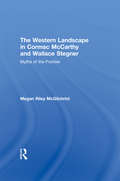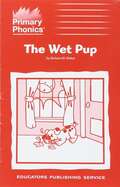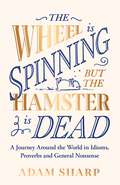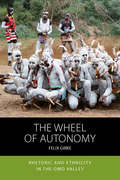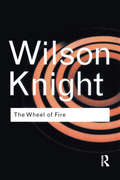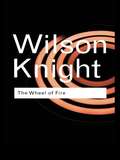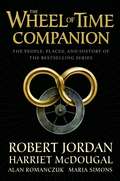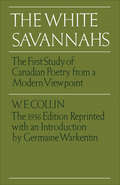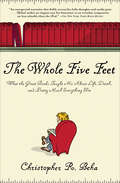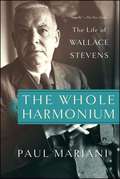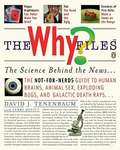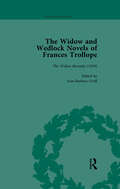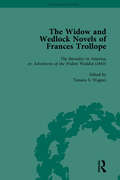- Table View
- List View
The Western Landscape in Cormac McCarthy and Wallace Stegner: Myths of the Frontier (Routledge Transnational Perspectives On American Literature Ser. #12)
by Megan McGilchristThe western American landscape has always had great significance in American thinking, requiring an unlikely union between frontier mythology and the reality of a fragile western environment. Additionally it has borne the burden of being a gendered space, seen by some as the traditional "virgin land" of the explorers and pioneers, subject to masculine desires, and by others as a masculine space in which the feminine is neither desired nor appreciated. Both Wallace Stegner and Cormac McCarthy focus on this landscape and environment; its spiritual, narrative, symbolic, imaginative, and ideological force is central to their work. In this study, McGilchrist shows how their various treatments of these issues relate to the social climates (pre- and post-Vietnam era) in which they were written, and how despite historical discontinuities, both Stegner and McCarthy reveal a similar unease about the effects of the myth of the frontier on American thought and life. The gendering of the landscape is revealed as indicative of the attempts to deny the failure of the myth, and to force the often numinous western landscape into parameters which will never contain it. Stegner's pre-Vietnam sensibility allows the natural world to emerge tentatively triumphant from the ruins of frontier mythology, whereas McCarthy's conclusions suggest a darker future for the West in particular and America in general. However, McGilchrist suggests that the conclusion of McCarthy's Border Trilogy, upon which her arguments regarding McCarthy are largely based, offers a gleam of hope in its final conclusion of acceptance of the feminine.
The Western Lit Survival Kit: An Irreverent Guide to the Classics, From Homer to Faulkner
by Sandra NewmanA side-splitting tour that makes it a blast to read the Western literary canon, from the ancient Greeks to the Modernists. To many, the Great Books evoke angst: the complicated Renaissance dramas we bluffed our way through in college, the dusty Everyman's Library editions that look classy on the shelf but make us feel guilty because they've never been opened. On a mission to restore the West's great works to their rightful place (they were intended to be entertaining!), Sandra Newman has produced a reading guide like no other. Beginning with Greek and Roman literature, she takes readers through hilarious detours and captivating historical tidbits on the road to Modernism. Along the way, we find parallels between Rabelais and South Park, Jane Austen and Sex and the City, Jonathan Swift and Jon Stewart, uncovering the original humor and riskiness that propelled great authors to celebrity. Packed with pop culture gems, stories of literary hoaxes, ironic day jobs for authors, bad reviews of books that would later become classics, and more.
The Wet Pup (Primary Phonics Storybook #Set 1A Book 7)
by Barbara W. MakarA systematic, phonics-based early reading program that includes: the most practice for every skill, decodable readers for every skill, and reinforcement materials--help struggling students succeed in the regular classroom
The Whaddayah Mean Leave Home and Travel for the Rest of My Life Book
by Gene Townsend Deanne Townsend"Gene and Deanne Townsend are full-time RV'ers who, at ages (Ahem!) "too young to retire" were advised by other full-timers: "If you're gonna' do it, go for it while you're young! Thus, they "sold it all" and hit the road, knowing that it would mean having to work for at least 20 more years. But loving the concept of making the entire United States their home so much, they accepted the challenge wholeheartedly! Now, years later, they are eager to share with you the pros and cons of this lifestyle of freedom!"-About the Authors
The Whale: In Search of the Giants of the Sea
by Philip HoareA travelogue through the history, literature, and lore of the remarkable mammals that we long have been fascinated with, from Moby-Dick to Free Willy.From his childhood fascination with the gigantic Natural History Museum model of a blue whale, to his abiding love of Moby-Dick, to his adult encounters with the living animals in the Atlantic Ocean, the acclaimed writer Philip Hoare has been obsessed with whales. The Whale is his unforgettable and moving attempt to explain why these strange and beautiful animals exert such a powerful hold on our imagination.Praise for The WhaleWinner of the Samuel Johnson Prize for Non-Fiction“This tour de force is a sensuous biography of the great mammals that range on and under Earth’s oceans.” —Publishers Weekly, starred review“The Whale is part cultural study, part travelogue, as Hoare traces the footsteps of Herman Melville from New York to New Bedford and Nantucket . . . [and] digresses on our abuses of the whale and the devastations of the whaling industry.” —Boston Globe“One of the most sublime reading experiences you’ll have this year.” —NPR’S All Things Considered
The Wheel
by Richard W. BullietIn this book, Richard W. Bulliet focuses on three major phases in the evolution of the wheel and their relationship to the needs and ambitions of human society. He begins in 4000 B.C.E. with the first wheels affixed to axles. He then follows with the innovation of wheels turning independently on their axles and concludes five thousand years later with the caster, a single rotating and pivoting wheel. Bulliet's most interesting finding is that a simple desire to move things from place to place did not drive the wheel's development. If that were the case, the wheel could have been invented at any time almost anywhere in the world. By dividing the history of this technology into three conceptual phases and focusing on the specific men, women, and societies that brought it about, Bulliet expands the social, economic, and political significance of a tool we only partially understand. He underscores the role of gender, combat, and competition in the design and manufacture of wheels, adding vivid imagery to illustrate each stage of their development.
The Wheel is Spinning but the Hamster is Dead: A Journey Around the World in Idioms, Proverbs and General Nonsense
by Adam SharpKnow your tater trap from your sniffle herring in Sharp's journey around the world in idioms, proverbs and general nonsense - the perfect gift for book lovers and language obsessives!'Brilliant, hilarious fun from a master wordsmith - you will LOVE this book' Kit de Waal'Extremely entertaining and very useful for new insults' Russell Kane'Utter genius' Marian Keyes'Brilliant' Brian BilstonJoin wordsmith Adam Sharp as he journeys around the world in idioms, proverbs and general nonsense. Learn unusual insults from France (You are a potato with the face of a guinea pig), how to hurry someone up in the US (You're going as slow as molasses in January) and what they call a shark in Vietnam (fat fish).Full of fascinating, ridiculous and hilarious translations from around the world, Adam has rounded up the very best of what every corner of the globe has to offer.Let's get this show on the road! Or:Let's saddle the chickens! (German)On with the butter! (Icelandic)Forward with the goat! (Dutch)
The Wheel is Spinning but the Hamster is Dead: A Journey Around the World in Idioms, Proverbs and General Nonsense
by Adam SharpKnow your tater trap from your sniffle herring in Sharp's journey around the world in idioms, proverbs and general nonsense - the perfect gift for book lovers and language obsessives!'Brilliant, hilarious fun from a master wordsmith - you will LOVE this book' Kit de Waal'Extremely entertaining and very useful for new insults' Russell Kane'Utter genius' Marian Keyes'Brilliant' Brian BilstonJoin wordsmith Adam Sharp as he journeys around the world in idioms, proverbs and general nonsense. Learn unusual insults from France (You are a potato with the face of a guinea pig), how to hurry someone up in the US (You're going as slow as molasses in January) and what they call a shark in Vietnam (fat fish).Full of fascinating, ridiculous and hilarious translations from around the world, Adam has rounded up the very best of what every corner of the globe has to offer.Let's get this show on the road! Or:Let's saddle the chickens! (German)On with the butter! (Icelandic)Forward with the goat! (Dutch)
The Wheel of Autonomy: Rhetoric and Ethnicity in the Omo Valley (Integration and Conflict Studies #18)
by Felix GirkeHow do the Kara, a small population residing on the eastern bank of the Omo River in southern Ethiopia, manage to be neither annexed nor exterminated by any of the larger groups that surround them? Through the theoretical lens of rhetoric, this book offers an interactionalist analysis of how the Kara negotiate ethnic and non-ethnic differences among themselves, the relations with their various neighbors, and eventually their integration in the Ethiopian state. The model of the “Wheel of Autonomy” captures the interplay of distinction, agency and autonomy that drives these dynamics and offers an innovative perspective on social relations.
The Wheel of Autonomy: Rhetoric and Ethnicity in the Omo Valley (Integration and Conflict Studies)
by Felix GirkeHow do the Kara, a small population residing on the eastern bank of the Omo River in southern Ethiopia, manage to be neither annexed nor exterminated by any of the larger groups that surround them? Through the theoretical lens of rhetoric, this book offers an interactionalist analysis of how the Kara negotiate ethnic and non-ethnic differences among themselves, the relations with their various neighbors, and eventually their integration in the Ethiopian state. The model of the “Wheel of Autonomy” captures the interplay of distinction, agency and autonomy that drives these dynamics and offers an innovative perspective on social relations.
The Wheel of Fire: Interpretations Of Shakespearean Tragedy (Routledge Classics)
by G. Wilson KnightOriginally published in 1930, this classic of modern Shakespeare criticism proves both enlightening and innovative. Standing head and shoulders above all other Shakespearean interpretations, this is the masterwork of the brilliant English scholar, G. Wilson Knight. Founding a new and influential school of Shakespearean criticism, Wheel of Fire was Knight's first venture in the field - his writing sparkles with insight and wit, and his analyses are key to contemporary understandings of Shakespeare.
The Wheel of Fire: Interpretations of Shakespearean Tragedy (Routledge Classics)
by G. Wilson KnightOriginally published in 1930, this classic of modern Shakespeare criticism proves both enlightening and innovative. Standing head and shoulders above all other Shakespearean interpretations, Wheel of Fire is the masterwork of the brilliant English scholar G. Wilson Knight. Founding a new and influential school of Shakespearean criticism, Wheel of Fire was Knight's first venture in the field - his writing sparkles with insight and wit, and his analyses are key to contemporary understandings of Shakespeare.
The Wheel of Time Companion: The People, Places, and History of the Bestselling Series (The Wheel of Time)
by Robert Jordan Alan Romanczuk Maria Simons Harriet McDougal<P>Since its debut in 1990, The Wheel of Time® by Robert Jordan has captivated millions of readers around the globe with its scope, originality, and compelling characters. Over the course of fifteen books and millions of words, the world that Jordan created grew in depth and complexity. However, only a fraction of what Jordan imagined ended up on the page, the rest going into his personal files. <P>Now The Wheel of Time Companion sheds light on some of the most intriguing aspects of the world, including biographies and motivations of many characters that never made it into the books, but helped bring Jordan's world to life.
The Wheel: Inventions and Reinventions (Columbia Studies in International and Global History)
by Richard BullietIn this book, Richard W. Bulliet focuses on three major phases in the evolution of the wheel and their relationship to the needs and ambitions of human society. He begins in 4000 B.C.E. with the first wheels affixed to axles. He then follows with the innovation of wheels turning independently on their axles and concludes five thousand years later with the caster, a single rotating and pivoting wheel.Bulliet's most interesting finding is that a simple desire to move things from place to place did not drive the wheel's development. If that were the case, the wheel could have been invented at any time almost anywhere in the world. By dividing the history of this technology into three conceptual phases and focusing on the specific men, women, and societies that brought it about, Bulliet expands the social, economic, and political significance of a tool we only partially understand. He underscores the role of gender, combat, and competition in the design and manufacture of wheels, adding vivid imagery to illustrate each stage of their development.
The Whiskey of Our Discontent: Gwendolyn Brooks as Conscience and Change Agent
by Quraysh Ali Lansana and Georgia A. Popoff“[A] superb tribute . . . [an] essential collection” of essays analyzing the works of the preeminent twentieth-century poet and voice of social justice (Booklist).Winner of the Central New York Book Award for NonfictionFinalist for the Chicago Review of Books AwardPoet, educator, and social activist Gwendolyn Brooks was a singular force in American culture.The first black woman to be named United States poet laureate, Brook’s poetry, fiction, and social commentary shed light on the beauty of humanity, the distinct qualities of black life and community, and the destructive effects of racism, sexism, and class inequality.A collection of thirty essays combining critical analysis and personal reflection, The Whiskey of Our Discontent, presents essential elements of Brooks’ oeuvre—on race, gender, class, community, and poetic craft, while also examining her life as poet, reporter, mentor, sage, activist, and educator.“Gwendolyn Brooks wrote and performed her magnificent poetry for and about the Black people of Chicago, and yet it was also read with anguish, delight, and awe by white people, successive waves of immigrants, and ultimately the world.” —Bill Ayers, from the Introduction
The White Goddess
by Robert GravesA history of poetic myth of the White Goddess as maid, nymph and crone in many lands and many times.
The White Savannahs: The First Study of Canadian Poetry from a Contemporary Viewpoint
by Germaine Warkentin Douglas Lochhead W. E. CollinThe White Savannahs, originally published in 1936, is the first study of Canadian poetry from a modern point of view. It contains essays on Archibald Lampman, Marjorie Pickthall, E.J. Pratt, Leo Kennedy, A.M. Klein, A.J.M. Smith, F.R. Scott, Marie Le Franc, and Dorothy Livesay. The contributions are based on a series of analytical essays originally published in the Canadian Forum and in the University of Toronto Quarterly. Professor Collin's work added much to the establishment of a new climate of opinion among readers and publishers of poetry in Canada.
The Whole Five Feet: What the Great Books Taught Me About Life, Death, and Pretty Much Everthing Else
by Christopher R. BehaThis unique memoir of reading the classics to find strength and wisdom &“makes an elegant case for literature as an everyday companion&” (The New York Times Book Review). While undergoing a series of personal and family crises, Christopher R. Beha discovered that his grandmother had used the Harvard Classics—the renowned &“five foot shelf&” of great world literature compiled in the early twentieth century by Charles William Eliot—to educate herself during the Great Depression. He decided to follow her example and turn to this series of great books for answers—and recounts the experience here in a smart, big-hearted, and inspirational mix of memoir and intellectual excursion that &“deftly illustrates how books can save one&’s life&” (Helen Schulman). &“As he grapples with the death of his beloved grandmother, a debilitating bout with Lyme disease and other major and minor calamities, Beha finds that writers as diverse as Wordsworth, Pascal, Kant and Mill had been there before, and that the results of their struggles to find meaning in life could inform his own.&” —The Seattle Times &“An important book [and] a sheer blast to read.&” —Heidi Julavits
The Whole Harmonium: The Life of Wallace Stevens
by Paul MarianiA perceptive, enlightening biography of one the most important American poets of the twentieth century--Wallace Stevens--as seen through his lifelong quest to find and describe the sublime in the human experience.Wallace Stevens lived a richly imaginative life that found expression in his poetry. His philosophical questioning, spiritual depth, and brilliantly inventive use of language would be profound influences on poets as diverse as William Carlos Williams, Hart Crane, Elizabeth Bishop, and John Ashbery. The Whole Harmonium presents Stevens within the living context of his times, as well as the creator of a poetry which has had a profound and lasting impact on the modern imagination itself. Stevens established his career as an executive even as he wrote his poetry, becoming a vice president with an insurance company in Hartford, Connecticut. His first and most influential book, Harmonium, was not published until he was forty-four years old. In these poems, Stevens drew on his interest in and understanding of modernism. Over time he became acquainted with the most accomplished of his contemporaries, Robert Frost and William Carlos Williams among them, but his personal style remained unique. He endured an increasingly unhappy marriage, losing himself by writing poetry in his study. Yet he had a witty, comic, and Dionysian side to his personality, including long fishing (and drinking) trips to Florida with his pals and a fascination with the sun-drenched tropics. People generally know two things about Wallace Stevens: that he is a "difficult" poet and that he was an insurance executive for most of his life. Stevens may be challenging to understand, but he is also greatly rewarding to read. Now, sixty years after Stevens's death, biographer and poet Paul Mariani shows how over the course of his life, Stevens sought out the ineffable and spiritual in human existence in his search for the sublime.
The Whole Journey: Shakespeare's Power of Development
by C. L. Barber Richard P. WheelerThis title is part of UC Press's Voices Revived program, which commemorates University of California Press’s mission to seek out and cultivate the brightest minds and give them voice, reach, and impact. Drawing on a backlist dating to 1893, Voices Revived makes high-quality, peer-reviewed scholarship accessible once again using print-on-demand technology. This title was originally published in 1986.
The Why Files
by Terry Devitt David J. TenenbaumScience magazine meets The Onion, Mental Floss, and Mad magazine in this ingenious guide to the science behind the newsFor more than a decade , the intrepid folks at whyfiles.org-the #1 science destination on the web-have been exploring the science behind newsworthy events. Now condensed into a book written with the site's characteristic wit, The Why Files features scores of articles organized into sections that mirror any city's daily newspaper: World News, Metro, Business Life, Sports, Arts & Leisure, Travel, Style, Opinion Page, and more. Who knew that science can explain why extremists say "God Told Us to Kill," how poker can make you sick, why great racehorses have big butts, and if electrocution is the best way to zap a bug? For those who love accurate science served up with humor in a one-of-a-kind newscast, this decidedly non-geeky guide is a must.
The Widow and Wedlock Novels of Frances Trollope Vol 1
by Brenda Ayres Tamara S Wagner Ann-Barbara Graff Abigail Burnham Bloom Elsie B MichieThe writings of Frances Trollope have been subject to increasing academic interest in recent years, and are now widely studied. In this four-volume set her comical, yet subversive, treatment of Victorian marriage provides an interesting contrast to some of the more earnest but conventional fiction of the time.
The Widow and Wedlock Novels of Frances Trollope Vol 2
by Brenda Ayres Tamara S Wagner Ann-Barbara Graff Abigail Burnham Bloom Elsie B MichieThe writings of Frances Trollope have been subject to increasing academic interest in recent years, and are now widely studied. In this four-volume set her comical, yet subversive, treatment of Victorian marriage provides an interesting contrast to some of the more earnest but conventional fiction of the time.
The Widow and Wedlock Novels of Frances Trollope Vol 3
by Brenda Ayres Tamara S Wagner Ann-Barbara Graff Abigail Burnham Bloom Elsie B MichieThe writings of Frances Trollope have been subject to increasing academic interest in recent years, and are now widely studied. In this four-volume set her comical, yet subversive, treatment of Victorian marriage provides an interesting contrast to some of the more earnest but conventional fiction of the time.
